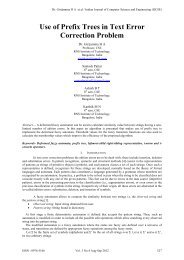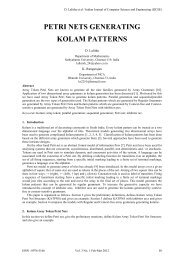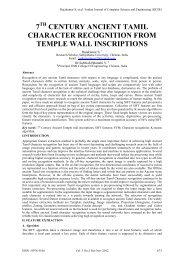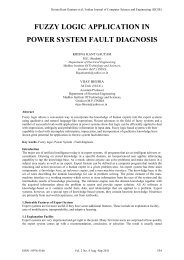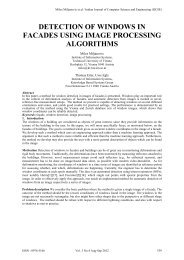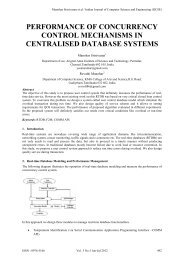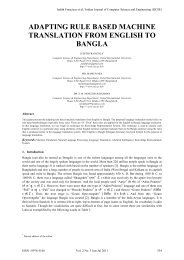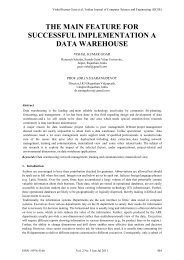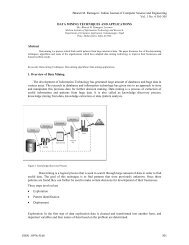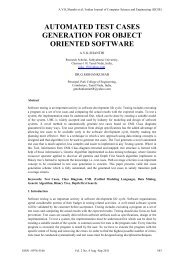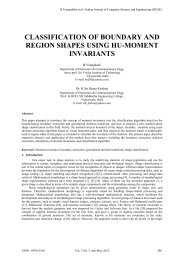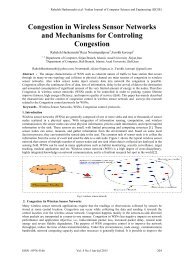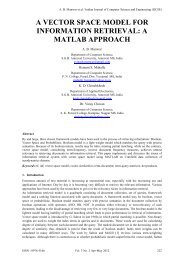comparison of purity and entropy of k-means clustering
comparison of purity and entropy of k-means clustering
comparison of purity and entropy of k-means clustering
You also want an ePaper? Increase the reach of your titles
YUMPU automatically turns print PDFs into web optimized ePapers that Google loves.
Satya Chaitanya Sripada et al./ Indian Journal <strong>of</strong> Computer Science <strong>and</strong> Engineering (IJCSE)<br />
The degree <strong>of</strong> occurring in a specified cluster is related to the reciprocal <strong>of</strong> the distance to compute the weights<br />
<strong>of</strong> the cluster.<br />
3. Contingency Matrix<br />
The basis for the calculation <strong>and</strong> computation <strong>of</strong> these validation measures is the contingency matrix. This is the<br />
key area for these measures <strong>and</strong> is done by building the matrix <strong>and</strong> finding the values.<br />
Table 1<br />
S 1 S 2 S 3 … S K′ Σ<br />
D 1 n 11 n 12 n 13 … n 1K′ n 1·<br />
D 2 n 21 n 22 n 23 … n 2K′ n 2·<br />
D 3 n 31 n 32 n 33 … n 3K′ n 3·<br />
. . . . . . .<br />
D K n K1 n K2 n K3 n KK′ n K·<br />
Σ n·1 n·2 n·3 n· K′ n<br />
We have n objects in our data set Z <strong>and</strong> suppose that the partition D = {D 1 , ・ ・ ・ , D K } <strong>of</strong> Z, where D i ∩<br />
Dj = ϕ <strong>and</strong> U K i=1 D i = Z for 1 ≤i # j ≤K, <strong>and</strong> the count <strong>of</strong> clusters is K, it <strong>means</strong> there are K numbered<br />
clusters. Secondly for our data set Z we suppose that there is another partition S= {S 1 , ・ ・ ・ ,S K′ } <strong>of</strong> Z,<br />
where S i ∩ S j = ϕ <strong>and</strong> U K′ i=1 S i = D for 1 ≤ i # j ≤ K′ which constitutes the true class labels where count <strong>of</strong><br />
clusters is K′, it <strong>means</strong> that K′ numbered <strong>of</strong> class clusters exist. The n ij plays a very prominent role in our<br />
contingency matrix. This represents the count <strong>of</strong> objects present in D i cluster from S j class cluster, the data<br />
points that occur <strong>and</strong> the overlap between the D i cluster <strong>and</strong> Sj class cluster are counted <strong>and</strong> this count is written<br />
as the n ij in our contingency matrix. For suppose K =3 <strong>and</strong> K’ = 3 which <strong>means</strong> that there are 3 clusters in K-<br />
<strong>means</strong> <strong>and</strong> we have 3 class cluster we represent a three by three contingency matrix. The values <strong>of</strong> p ij , p i <strong>and</strong> p j<br />
are computed by pij = n ij / n, pi = n i· / n <strong>and</strong> pj = n·j / n.<br />
4. External Validation Measures<br />
To measure the quality <strong>of</strong> any thing we require an index. Quality is very essential characteristic <strong>and</strong><br />
distinguishing property <strong>of</strong> something. External validation is done class labels. Definition <strong>of</strong> the external<br />
validation indices: They are used to measure the extent to which cluster labels affirm with the externally given<br />
class labels. The class labels also known as ground truth are taken as base value. The external validation<br />
measures are extremely useful in deducing the ambit to which the <strong>clustering</strong> structure is ascertained by a<br />
<strong>clustering</strong> algorithm that matches some external structure. This is compared to the individual designated class<br />
labels. External validation measures criteria evaluate the final <strong>clustering</strong> output result with respect to a pre<br />
designated structure. For many applications these external validation measures are very much applicable. An<br />
illustration about the external validation measures exhibits that document <strong>clustering</strong> algorithm can pave to the<br />
results <strong>of</strong> <strong>clustering</strong> that match the distribution accomplishment by specialists.<br />
There are many external validation measures like Purity, R<strong>and</strong> Statistics, Entropy, Jaccard Coefficient, Mutual<br />
information, Fowlkes <strong>and</strong> Mallows Index, Minkowski score <strong>and</strong> Goodman – Kruskals Coefficient etc. We<br />
focus 3 external validation measures Purity, Entropy <strong>and</strong> F-measure. Here we discuss about the <strong>clustering</strong><br />
methods, Fuzzy C-Means <strong>and</strong> K-Means. The distance between various data points <strong>of</strong> the clusters generated by<br />
ISSN : 0976-5166 Vol. 2 No. 3 Jun-Jul 2011 344



